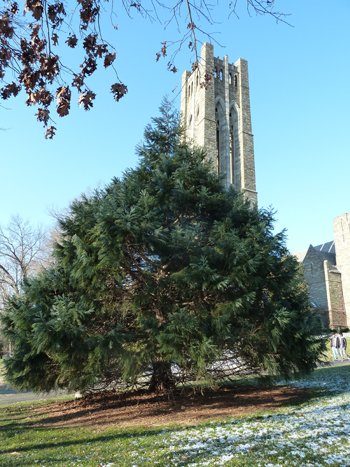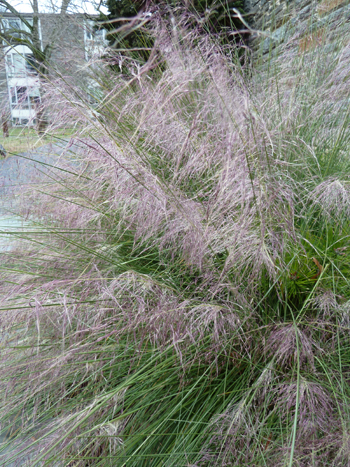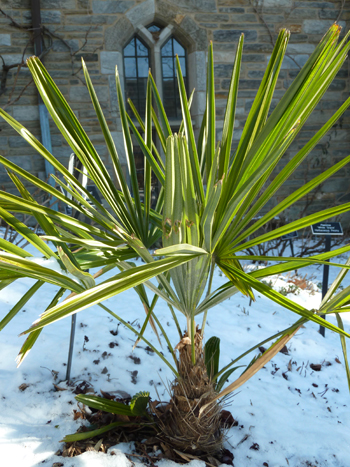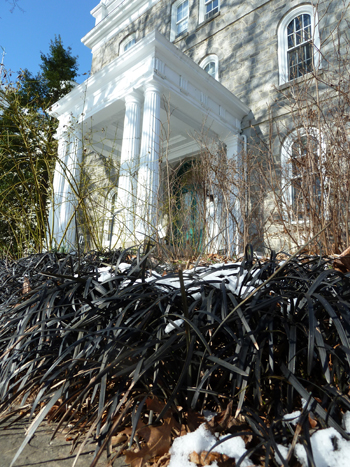Plants of Week – January 28
 Sequoiadendron giganteum ‘Hazel Smith’ is considered one of the hardiest forms of giant sequoia and is noted as a strong grower with blue-green needles. A chance seedling, S. giganteum ‘Hazel Smith’ was selected by Don and Hazel Smith of Watnog Nursery. Hardy in zones 5 – 9, expect the evergreen tree to grow 14’ tall and 10’ wide in ten years. A Hershey Kiss-shaped specimen roughly twenty years old can be seen on Parrish Lawn near a Cedrus deodora ‘Roman Gold’. Photo credit: J. Coceano
Sequoiadendron giganteum ‘Hazel Smith’ is considered one of the hardiest forms of giant sequoia and is noted as a strong grower with blue-green needles. A chance seedling, S. giganteum ‘Hazel Smith’ was selected by Don and Hazel Smith of Watnog Nursery. Hardy in zones 5 – 9, expect the evergreen tree to grow 14’ tall and 10’ wide in ten years. A Hershey Kiss-shaped specimen roughly twenty years old can be seen on Parrish Lawn near a Cedrus deodora ‘Roman Gold’. Photo credit: J. Coceano
Wanting to take your garden to the dark side? Try Ophiopogon planiscapus ‘Nigrescens’. Commonly known as black mondo grass, O. planiscapus ‘Nigrescens’ is also sold under the cultivar names ‘Arabicus’ and ‘Ebony Knight’. Plant Delights Nursery, a purveyor of several Ophiopogon species and cultivars, suggests planting on 10 – 12” centers as the rhizomatous perennial in Ruscaceae is slow to spread. Leaves remain evergreen throughout the winter and is a great backdrop for snowdrops. Photo credit: J. Coceano
 In autumn Muhlenbergia capillaris erupts with masses of billowy pink inflorescence. The grass, while noted for its tolerance of poor, dry soils is intolerant of winter wet. Plants reach 2 – 3’ in height with a similar spread. Photo credit: J. Coceano
In autumn Muhlenbergia capillaris erupts with masses of billowy pink inflorescence. The grass, while noted for its tolerance of poor, dry soils is intolerant of winter wet. Plants reach 2 – 3’ in height with a similar spread. Photo credit: J. Coceano
 The needle palm, Rhapidophyllum hystrix, is a shrubby, nearly trunk-less fan palm reaching 4 – 6’ in height. It is considered to be one of the most winter hardy palms to USDA zone 6b. Young plants are most vulnerable to cold, thus site in a protected location such as a southern facing slope or within a courtyard sheltered from winter winds. R. hystrix is native to the moist bottomlands of the southeastern United States. Mature clumps sucker along the stem forming a dramatic display. Photo credit: J. Coceano
The needle palm, Rhapidophyllum hystrix, is a shrubby, nearly trunk-less fan palm reaching 4 – 6’ in height. It is considered to be one of the most winter hardy palms to USDA zone 6b. Young plants are most vulnerable to cold, thus site in a protected location such as a southern facing slope or within a courtyard sheltered from winter winds. R. hystrix is native to the moist bottomlands of the southeastern United States. Mature clumps sucker along the stem forming a dramatic display. Photo credit: J. Coceano






No Comments